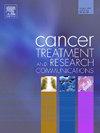HOXB and HOXD genes contribute to the carcinogenic processes in glioblastoma: evidence form a bioinformatics analysis
IF 2.4
Q3 Medicine
引用次数: 0
Abstract
Purpose
Glioblastoma is an aggressive cancer that affects the brain. The Homeobox B and D (HOXB/D) family has been linked to tumor progression, but their exact mechanism remains unclear.
Material and methods
This study aimed to identify critical HOXB/D family members associated with glioblastoma and analyze their expression in glioblastoma using the GEPIA2 database. The study also assessed genetic alterations, their related transcription factors, miRNAs, gene-gene interactions, and correlations between their expression and immune infiltration using databases like cBioPortal, miRNet, GeneMANIA, and GSCA.
Results
We showed that HOXB2/3/7 and HOXD3/8/9/10/11/13 expression was higher in glioblastoma samples compared to normal samples. Increased expression of HOXB2/5/8/9/13 was associated with negative effects on overall survival (OS), disease-specific survival (DSS), and progression-free survival (PFS), while overexpression of HOXB2/5/9 was linked to inferior PFS. Heightened levels of HOXD4/9, HOXD9/11, and HOXD9/10/11 expression in glioblastoma patients were correlated with unfavorable outcomes in terms of OS, DSS, and PFS. HOXB/D genes were related to 20 different genes, mainly enriched in the Activation of HOX Genes During Differentiation R-HSA-5619507 pathway. Immune cells were linked to specific genes in glioblastoma, with HOXB2 and HOXD3 expression potentially causing resistance to Methotrexate and Z-LLNle-CHO, HOXB7 indicating sensitivity to Lapatinib but resistance to 18 other small molecules, HOXD8 leading to resistance against 5 small molecules, and upregulated HOXD9, HOXD10, and HOXD13 suggesting sensitivity to 2, 4, and 9 small molecules, respectively.
Conclusion
Taken together, we showed contribution of HOXB and HOXD genes in the carcinogenic processes and proposed them as possible targets for treatment options.
HOXB和HOXD基因参与胶质母细胞瘤的致癌过程:来自生物信息学分析的证据
胶质母细胞瘤是一种影响大脑的侵袭性癌症。Homeobox B和D (HOXB/D)家族与肿瘤进展有关,但其确切机制尚不清楚。材料和方法本研究旨在利用GEPIA2数据库确定与胶质母细胞瘤相关的关键HOXB/D家族成员,并分析其在胶质母细胞瘤中的表达。该研究还评估了遗传改变、相关转录因子、miRNAs、基因-基因相互作用,以及它们的表达与免疫浸润之间的相关性,使用的数据库包括cbiopportal、miRNet、GeneMANIA和GSCA。结果HOXB2/3/7和HOXD3/8/9/10/11/13在胶质母细胞瘤组织中的表达高于正常组织。HOXB2/5/8/9/13的表达增加与总生存期(OS)、疾病特异性生存期(DSS)和无进展生存期(PFS)的负面影响相关,而HOXB2/5/9的过表达与较差的PFS相关。在胶质母细胞瘤患者中,HOXD4/9、HOXD9/11和HOXD9/10/11表达水平升高与OS、DSS和PFS方面的不利结果相关。HOXB/D基因与20个不同的基因相关,主要富集于分化过程中HOX基因的激活R-HSA-5619507通路。免疫细胞与胶质母细胞瘤中的特定基因相关,HOXB2和HOXD3的表达可能导致对甲氨蝶呤和Z-LLNle-CHO的耐药,HOXB7对拉帕替尼敏感,但对其他18个小分子有抗性,HOXD8导致对5个小分子的耐药,HOXD9、HOXD10和HOXD13的上调分别提示对2、4和9个小分子敏感。综上所述,我们发现HOXB和HOXD基因在致癌过程中的作用,并提出它们可能是治疗方案的靶点。
本文章由计算机程序翻译,如有差异,请以英文原文为准。
求助全文
约1分钟内获得全文
求助全文
来源期刊

Cancer treatment and research communications
Medicine-Oncology
CiteScore
4.30
自引率
0.00%
发文量
148
审稿时长
56 days
期刊介绍:
Cancer Treatment and Research Communications is an international peer-reviewed publication dedicated to providing comprehensive basic, translational, and clinical oncology research. The journal is devoted to articles on detection, diagnosis, prevention, policy, and treatment of cancer and provides a global forum for the nurturing and development of future generations of oncology scientists. Cancer Treatment and Research Communications publishes comprehensive reviews and original studies describing various aspects of basic through clinical research of all tumor types. The journal also accepts clinical studies in oncology, with an emphasis on prospective early phase clinical trials. Specific areas of interest include basic, translational, and clinical research and mechanistic approaches; cancer biology; molecular carcinogenesis; genetics and genomics; stem cell and developmental biology; immunology; molecular and cellular oncology; systems biology; drug sensitivity and resistance; gene and antisense therapy; pathology, markers, and prognostic indicators; chemoprevention strategies; multimodality therapy; cancer policy; and integration of various approaches. Our mission is to be the premier source of relevant information through promoting excellence in research and facilitating the timely translation of that science to health care and clinical practice.
 求助内容:
求助内容: 应助结果提醒方式:
应助结果提醒方式:


